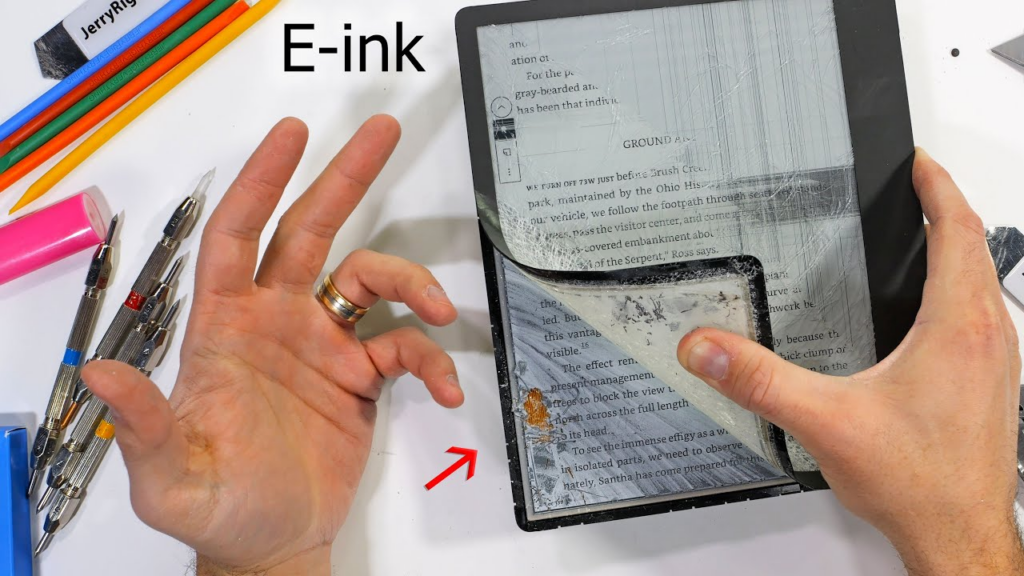–

INDRODUCTION:
E-ink displays, also known as electronic ink displays, are a revolutionary technology designed to mimic the appearance of ink on paper. These displays are made up of tiny microcapsules that contain charged particles, and they are widely recognized for their low power consumption, high readability, and paper-like visual appearance. Unlike traditional backlit screens, which emit light, E-ink displays are reflective—meaning they work by reflecting ambient light, similar to how paper does. This makes them particularly well-suited for environments with bright light, such as outdoor settings.
The most widely recognized use of E-ink is in devices like the Amazon Kindle, Kobo e-readers, and Barnes & Noble Nook. However, E-ink is also expanding into other areas, such as wearables, digital signage, and flexible, rollable displays.
Key Features of E-Ink Displays:
Paper-like quality: The primary appeal of E-ink is its ability to mimic the look of ink on paper. It’s easy on the eyes, especially for long reading sessions, and doesn’t cause the glare associated with traditional screens.
Low power consumption: E-ink technology uses power only when the content on the screen changes. This means e-readers with E-ink displays can last for weeks on a single charge.
Readability in direct sunlight: Since E-ink is reflective, it performs exceptionally well in bright conditions, unlike backlit LCD or OLED screens that can become hard to read under sunlight.
Wide viewing angles: E-ink displays offer excellent readability from almost any angle, further improving the experience of reading.
Applications:
E-readers: E-ink is most commonly used in e-readers, where its low power usage and paper-like quality make it ideal for long-form reading.
Digital signage: E-ink displays are being used for digital price tags, store signs, and other applications in retail. They are energy-efficient and can be updated remotely.
Wearables and Smart Devices: E-ink is also found in wearables, such as smartwatches and fitness trackers, where long battery life is essential. Some devices like the Pebble Smartwatch and InkCase phone cases have featured E-ink screens.
Flexible Displays: The technology is being explored for its ability to create flexible, foldable, or even rollable displays, with potential applications in fashion, packaging, and future device designs.
Electronic Paper: Larger-scale E-ink displays are being tested for applications such as electronic newspapers, signage, and bulletin boards that can change content without requiring constant power.
Advantages:
Low Power Consumption:
One of the biggest advantages of E-ink technology is its extremely low power consumption. Unlike LCD or OLED screens, which require a constant supply of power to maintain the image, E-ink displays only use energy when the content on the screen changes. This means that once the image or text is displayed, no additional power is needed to keep it visible. This is why e-readers like the Amazon Kindle can last for weeks on a single charge.
Readability in Bright Light:
E-ink displays are reflective, which means they don’t emit light. Instead, they reflect ambient light, just like paper does. This makes them easier to read in bright sunlight or outdoor conditions compared to backlit screens (like LCD and OLED), which can often become hard to read in direct sunlight due to glare.
Paper-like Appearance:
The technology is specifically designed to mimic the look of ink on paper, making it highly suitable for activities like reading. The text and images on an E-ink screen look sharp and crisp, without the unnatural backlighting or pixelation seen on traditional displays. This creates a more natural reading experience, similar to reading a printed book, which is particularly useful for long reading sessions.
Reduced Eye Strain:
Because E-ink displays do not emit light, they are much less straining on the eyes than traditional screens. Backlit screens (like those on smartphones and computers) can cause eye fatigue after prolonged use, especially in low light. In contrast, E-ink screens reduce the likelihood of eye strain, making them ideal for people who read for hours at a time.
Wide Viewing Angles:
E-ink displays offer excellent viewing angles, meaning the content remains clear and legible even when viewed from different angles. This is a significant advantage compared to many other screen technologies, where the image quality degrades as you shift your position relative to the screen.
Disadvantages:
Slow Refresh Rate:E-ink screens are much slower at refreshing content compared to traditional LCD or OLED displays. This means they are not ideal for dynamic content like videos or fast-moving images.
Limited Color Range: Most e-ink displays are monochrome, meaning they only display black and white. While color e-ink displays are emerging, their quality and color range are still far behind traditional screens.
Lack of Backlight: E-ink screens do not have their own backlight, which can make them harder to read in low-light conditions unless additional light sources (like a lamp) are used. Some e-readers have built-in front lighting, but it’s not as bright or uniform as the backlight in an LCD or OLED screen.
Low Resolution for Detailed Graphics: While e-ink screens are excellent for text, their resolution often falls short when it comes to displaying detailed graphics or intricate images.
Monotony of Design: Since e-ink technology is usually limited to simple designs with slower refresh rates, it’s not suited for anything that requires a flashy or high-quality visual experience, such as gaming or streaming.
Fragility: Some e-ink screens can be more fragile than traditional displays, as they are made of thin plastic and can crack under pressure or impact.
